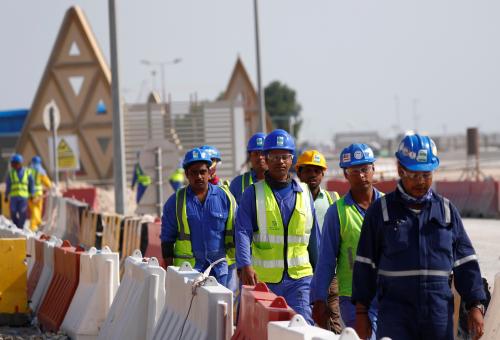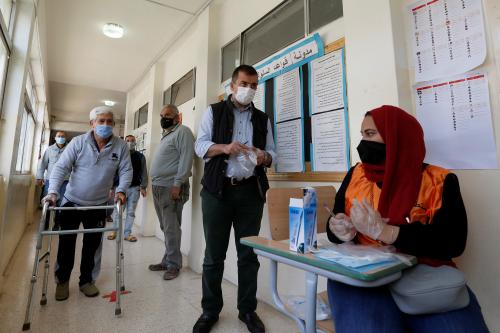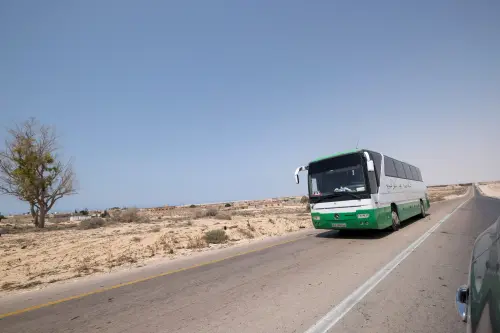Content from the Brookings Doha Center is now archived. In September 2021, after 14 years of impactful partnership, Brookings and the Brookings Doha Center announced that they were ending their affiliation. The Brookings Doha Center is now the Middle East Council on Global Affairs, a separate public policy institution based in Qatar.
2016 ushered in the revamped UN Sustainable Development Goals (SDGs), which built on the Millennium Development Goals (MDGs), adopted in 2000. Poverty eradication is the number one developmental goal of both the MDGs and SDGs.
Over the past two decades, global efforts have been successful as the number of people living in poverty declined by more than half, from more than 1.9 billion in 1990 to 836 million in 2015. Despite such progress, the Arab world continues to lag in its efforts to combat poverty.
In fact, according to the UNDP, between 2010 and 2012, the percentage of the population in the region making less than $1.25 a day increased (PDF) from 4.1 percent to 7.4 percent. Previously, countries in the region had made progress in reducing poverty, but high levels of political unrest had reversed many of these improvements.
Poverty and conflict: A direct correlation
The persistence of conflict in Syria, Iraq, and Yemen remains one of the main drivers of poverty regionally. In Syria, after five years of civil war it is estimated that 80 percent of the population lives in poverty, and life expectancy has been cut by 20 years.
Almost a decade after the US-led invasion in 2003, poverty rates are on the rise in Iraq with statistics from the World Bank showing that 28 percent of Iraqi families live under the poverty line. The mass displacement from the Islamic State of Iraq and the Levant (ISIL) controlled areas, the decline in global oil prices and higher unemployment rates has meant that despite its oil wealth, the Iraqi government has failed miserably in addressing the poverty rate in the country.
Yemen’s poverty rate has increased from 42 percent of the population in 2009, to an even more alarming 54.5 percent in 2012.
Despite an initial wave of optimism after the 2011 Arab uprisings, countries in North Africa continue to face economic challenges that have seen poverty rates increase in many areas.
In Egypt, the Arab world’s most populous country, five years of political upheaval have taken a toll on the economy. Increased unemployment, lower tourist arrivals, dwindling foreign currency reserves, and a weaker Egyptian pound has meant that 26 percent of Egypt’s 90 million people live under the poverty line.
Despite a relatively successful and ongoing political transition in Tunisia, one in every six Tunisians lives below the poverty line as well. Tunisia is one of the highest contributors of ISIL fighters per capita, and Tunisian leaders continue to make a direct correlation between poverty and terrorism.
In the Palestinian territories, a lack of employment opportunities due to restrictions imposed by the Israeli occupation continues to drive rising levels of poverty (PDF). Nearly two years after the war in Gaza, reconstruction efforts have slowed to a crawl. Such efforts promised employment for thousands of Palestinians; however, the slow trickle of foreign donations and a deficiency of construction materials indicate that the situation will not improve any time soon.
Although the outlook for the West Bank appears less grim than in Gaza, high levels of poverty persist as many Palestinians hold jobs that pay a meager wage. This shortage of suitable employment forces many Palestinians to seek employment from companies operating in settlements on occupied Palestinian territory.
Even with some Palestinians performing these jobs out of necessity, per capita income in the West Bank continues to decline. In Gaza, the situation is even worse with per capita income 31 percent lower than in 1994.
One step forward, two steps back
The SDGs provide an ambitious blue print for global development that includes a focus on education, the environment, women’s rights, sustainable water, and many other critical areas. While all of these issues are of importance to the region, it will become increasingly problematic to progress these goals without a renewed emphasis on poverty eradication.
Countries currently in conflict pose the greatest challenge to poverty eradication efforts, as participants in these conflicts have pushed aside humanitarian concerns in the quest for victory. The international community should make preparations for post-war reconstruction in Syria and Yemen, while also remaining wary of incomplete political settlements that raise the prospect for the resumption of hostilities in the future.
Even though in Palestine it is unlikely that the Israeli occupation will end anytime soon, however Fatah and Hamas should work toward a reconciliation to improve the system of governance in the territories. This will provide Palestinians with a united front to tackle the challenges posed by the occupation and ease the suffering felt in both Gaza and the West Bank.
Arab countries must recognise that absolute poverty is only one dimension of the problem and that redistributive policies can only go as far to address the issue. The uprisings have shown that Arab youth not only protested against economic inequality, but also against marginalisation and political disenfranchisement. Any renewed push for more economic opportunities must also provide Arab youth with a chance to shape their future.
Lower oil prices will likely affect the level of aid wealthier Gulf Cooperation Council countries give to poorer countries in the region. Nonetheless, such aid should not simply dry up. The Saudi-led coalition has destroyed a large portion of the Yemeni infrastructure, so the Kingdom and members of its coalition should bear a large part of the reconstruction effort.
Arab governments should understand that poverty also has a security and stability dimension. The 2011 uprisings have shown that Arab societies have the ability to challenge incompetent governance and corruption.
Food security remains a huge challenge for a region that imports much of its key food staples. Should poverty and food security issues not be addressed, any future protest wave may constitute a “revolution of the hungry”, that is likely to be more violent than the protest wave of 2011.
This article originally appeared in Al Jazeera English.



Commentary
Op-edThe persistence of poverty in the Arab world
February 28, 2016